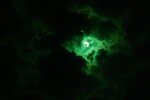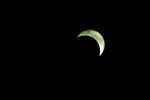REGION — Just because we aren’t in the path of totality—the 115-mile swathe of complete darkness, which will pass through western PA and New York as the sun is eclipsed by the …
Stay informed about your community and support local independent journalism.
Subscribe to The River Reporter today. click here
This item is available in full to subscribers.
Please log in to continue |


REGION — Just because we aren’t in the path of totality—the 115-mile swathe of complete darkness, which will pass through western PA and New York as the sun is eclipsed by the moon—doesn’t mean we can’t enjoy the eclipse.
Pat Leonard of the Cornell Lab of Ornithology writes in the Cornell Chronicle that scientists will be out on the day, watching what birds and insects do during a total eclipse. (Birds, she notes, are in the process of migration now.)
BirdCast examined bird behavior during the 2017 eclipse. One person noted that a large flock of purple martins dropped from the sky to sit on wires or in trees. Normally vocal, the birds were quiet through the eclipse, but when it was over they went back to flying.
Radar, the site added, confirmed an emptying sky during the eclipse.
Make a pinhole viewer from a cereal box! Create a model of the Earth and sun! You’ll find those activities and more at scope.asu.edu/eclipse-activities/.
Then for more science, visit www.science.nasa.gov/eclipses/.
The River Reporter’s Amanda Reed has a few suggestions about taking photos of an eclipse.
Use a very high ISO—last eclipse she used an ISO of 6400 but new cameras can go higher.
If you’re going to try it with welder’s glasses [Shade 14 is recommended online], be aware that the changing light means a lot of adjusting to get clean shots.
NASA recommends using the appropriate solar filters.
Reed adds that the sun moves faster in the sky than you think, so you’ll have to adjust your setup for that.
She also suggests shooting in RAW if you can.
In your eyes, the lens focuses light on the retina in back, letting you see clearly. Looking at the sun will focus all that light on the retina too—and it can cause burns, in a condition called solar retinopathy.
Damage and vision loss can be permanent, according to the American Academy of Ophthalmology. See why at www.aao.org/eye-health/tips-prevention/how-sun-can-burn-your-retina-in-seconds.
NASA strongly recommends special eclipse glasses or a handheld solar viewer. Sunglasses are not adequate protection.
For more safety information, visit www.science.nasa.gov/eclipses/future-eclipses/eclipse-2024/safety/.
The earliest observed, in 3340 B.C.E.; one in 585 B.C.E. that might have stopped a war; eclipses in Jerusalem in 29 and 33 that might date the death of Jesus; the first successful photo of totality, taken in 1851; and in 1919, when during an eclipse astronomers proved that gravity warps space. Read more at www.astronomy.com/observing/a-timeline-of-famous-eclipses/ and www.space.com/18458-famous-so lar-eclipses-history.html.
We’re not done with the eclipse! Head over to Jonathan Charles Fox’s column, which will update you on local eclipse-related activities, share myths and superstitions that have grown up around eclipses and much more.
Comments
No comments on this item Please log in to comment by clicking here